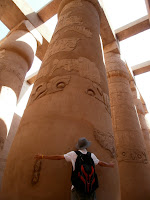After two long days in the heat, we got up this morning determined to visit one last monument before we had to catch our flight. We were a bit surprised to discover that the beginning of Ramadan is accompanied by the clocks moving back an hour, so we actually had more time than we thought. It was a short ride to our destination of the morning – the Karnak temple.
A few quick facts about Karnak before I jump into description: It is the largest religious site in the world covering two sq km, 81,000 people were used to build and maintain it, a number of different rulers added onto it over centuries, the Nile used to flood a few feet of it, and it has its own lake.
 |
| Entrance to Karnak |
The entrance way is lined with statues of what look like big horn sheep (at least the heads do, the bodies kind of look like lions.). There are about a dozen on either side. Following the path through the first open courtyard, you come to an area filled with massive columns. The bottom four feet of each column are plain from where the Nile has washed them away, but the tops are covered in hieroglyphs. The walls are also covered, some are “raised” hieroglyphs done by one pharaoh, and others are “sunken” (and evidently more crude) done by a different pharaoh, depending on their tastes. After this room you enter another courtyard where the obelisk of Hatshepsut stands (it is the tallest one in Egypt, and it couldn’t be destroyed by Tuthmosis III cause it has markings of the gods on it). From there the complex opens up. There are areas with many statues, lots of separate religious temples, a doorway that was put in during the reign of Alexander the Great, and of course the royal lake (which we assume was changed every year with the flooding of the Nile).
 |
| The columns were massive |
One of the coolest things about Karnak was some of the drawings on the walls. The people’s feet or even the bottom of boats would rest right where the water lines from the Nile were. It would certainly take years to map out exactly where the Nile would rise to and carve out inscriptions that weren’t too far down. I was truly amazed. Finally, after spending a while wandering around the rest of the temple, we took a taxi back to the hotel, packed, and headed for the airport.
 |
| No really. Massive. |
Honestly, the Luxor airport looked like it had closed when we arrived. Fortunately there were a few people inside, and our flight ended up being almost full, but you could never tell from the outside. On the runway there were literally two other planes besides ours. But a flight back is a flight back, and we were back to our hotel by 4. We sat around for a little bit, and then about 7:30 we headed out to check out the Khan al-Khalili bazaar.
 |
| The lake at Karnak |
It was eerie. The streets were empty. We realized that everyone had gone inside to eat right as it got dark, but we underestimated the gravity with which this took place. It was kind of nice to just walk around and not be hounded by taxis or bump into people on the sidewalk, but the entire city just shuts down. The market wasn’t completely closed, but less than half of the shops were open (which was still plenty for me to handle). The couple of restaurants we tried were either closed or only serving a set menu for the first meal of Ramadan. Thus, we headed back towards our hotel and ate at a restaurant near it. I had a different version of chicken kabob and rice, which was pretty good. Afterwards we went back to our room to hang out for a while and decide if we wanted to go out. Instead, while both of us were lying on our beds reading, we just decided a little extra sleep wouldn’t be a bad thing, and we dozed off around 10.
 |
| Pat and I at Karnak |
 |
| The Luxor airport |
Goodnight.






Quesion: What kind of liquor do they have in Cairo?
ReplyDelete